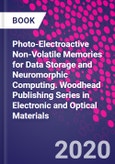Photo-Electroactive Non-Volatile Memories for Data Storage and Neuromorphic Computing summarizes advances in the development of photo-electroactive memories and neuromorphic computing systems, suggests possible solutions to the challenges of device design, and evaluates the prospects for commercial applications. Sections covers developments in electro-photoactive memory, and photonic neuromorphic and in-memory computing, including discussions on design concepts, operation principles and basic storage mechanism of optoelectronic memory devices, potential materials from organic molecules, semiconductor quantum dots to two-dimensional materials with desirable electrical and optical properties, device challenges, and possible strategies.
This comprehensive, accessible and up-to-date book will be of particular interest to graduate students and researchers in solid-state electronics. It is an invaluable systematic introduction to the memory characteristics, operation principles and storage mechanisms of the latest reported electro-photoactive memory devices.
Please Note: This is an On Demand product, delivery may take up to 11 working days after payment has been received.
Table of Contents
1. Introduction to photo-electroactive non-volatile memory 2. Characteristics and mechanisms in resistive switching memories 3. Memory characteristics and mechanisms in transistor based memories 4. Two-terminal optoelectronic memory device 5. Three-terminal optoelectronic memory device 6. Synaptic devices based on organic field-effect transistors 7. Ionic synergetically coupled electrolyte gated transistors for neuromorphic engineering applications 8. One-dimensional materials for photo-electroactive memories and synaptic devices 9. Novel photo-electroactive memories and neuromorphic devices based on nanomaterials 10. Organic and Hybrid Photo-Electroactive Polymer for Memories and Neuromorphic Computing 11. Metal oxide materials for photo-electroactive memories and neuromorphic computing systems 12. Perovskites for photo-tunable memories and neuromorphic computing 13. Chalcogenide materials for optoelectronic memory and neurmorphic computing 14. Device challenges, possible strategies and conclusions








